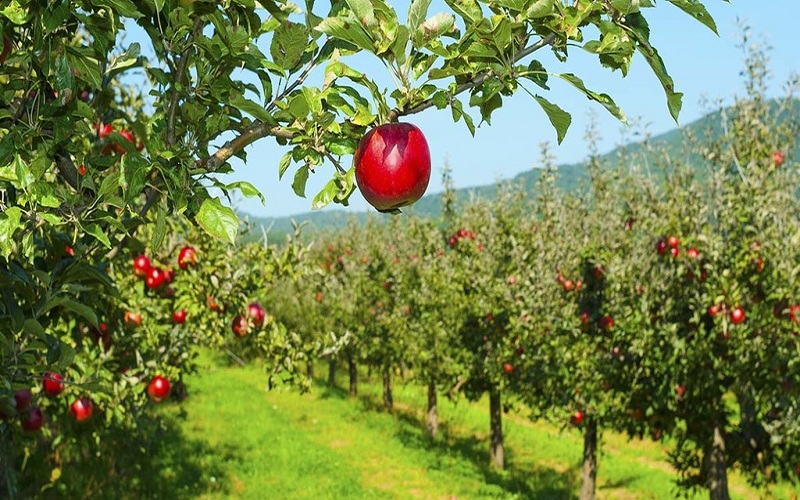The first and most crucial step in creating an orchard is selecting the appropriate location. The success of your orchard depends significantly on the site you choose. Factors such as sunlight, soil quality, and drainage play a pivotal role in determining the health and productivity of your trees.
Sunlight
Fruit trees require ample sunlight to thrive. Ideally, your orchard should be situated in an area that receives at least six to eight hours of direct sunlight daily. Avoid locations with excessive shade, as insufficient sunlight can lead to poor fruit development and increased susceptibility to diseases.
Soil Quality
Soil quality is another critical factor to consider. Conduct a soil test to determine its pH level and nutrient content. Most fruit trees prefer slightly acidic to neutral soil (pH 6.0-7.0). If your soil is too acidic or alkaline, you can amend it with lime or sulfur to achieve the desired pH level. Additionally, ensure the soil is well-draining, as waterlogged soil can lead to root rot and other issues.
Drainage
Proper drainage is essential for the health of your orchard. Avoid low-lying areas prone to water accumulation. If your site has poor drainage, consider creating raised beds or mounds to improve water flow. Installing drainage tiles or ditches can also help manage excess water.
Selecting Fruit Trees
According to Chris Bowers & Sons, choosing the right fruit trees for sale for your orchard involves considering factors such as climate, tree size, and pollination requirements. Britain’s climate is conducive to a wide variety of fruit trees, but it’s essential to select varieties that are well-suited to your specific region.
Climate and Hardiness
Different fruit trees have varying levels of hardiness, which refers to their ability to withstand cold temperatures. In Britain, where winters can be harsh, it is vital to choose hardy varieties that can survive the cold months. Apples, pears, plums, and cherries are among the most common and reliable choices for British orchards.
Tree Size
Fruit trees come in various sizes, including standard, semi-dwarf, and dwarf. Standard trees grow to their full height and require more space, making them suitable for larger orchards. Semi-dwarf and dwarf trees are more compact, making them ideal for smaller gardens and easier to manage. Dwarf trees also bear fruit earlier than their larger counterparts.
Pollination
Pollination is crucial for fruit production. Some fruit trees are self-pollinating, meaning they do not require another tree to produce fruit. However, many trees, such as apples and pears, require cross-pollination from another compatible variety. Planting multiple varieties that bloom simultaneously can enhance pollination and increase fruit yield.
Planting Your Orchard
Once you have selected the site and chosen your fruit trees, it’s time to plant your orchard. Proper planting techniques are essential to ensure the healthy establishment and growth of your trees.
Timing
The best time to plant fruit trees in Britain is during the dormant season, typically between late autumn and early spring. Planting during this period allows the trees to establish their root systems before the growing season begins.
Spacing
Proper spacing is critical to prevent overcrowding and ensure adequate airflow, reducing the risk of diseases. The spacing requirements vary depending on the tree size. Standard trees should be spaced about 20-30 feet apart, semi-dwarf trees 12-15 feet apart, and dwarf trees 8-10 feet apart.
Planting Process
Digging the Hole: Dig a hole that is twice the width and the same depth as the tree’s root ball. This allows the roots to spread out easily.
Preparing the Soil: Mix the excavated soil with compost or well-rotted manure to improve fertility and drainage.
Planting the Tree: Make sure the swelling area where the tree is grafted onto the rootstock—the graft union—is above the ground level when you place the tree in the hole. Fill the hole with the corrected dirt, then gently firm it to remove air pockets.
Watering: After the tree has been planted, it should be thoroughly watered to assist in the soil’s settling around the roots. Maintain a consistent watering schedule, particularly during periods of drought.
Caring for Your Orchard
Proper care and maintenance are vital for the health and productivity of your orchard. This involves watering, fertilizing, pruning, and pest management.
Watering
Young fruit trees need consistent moisture to establish their root systems. Water deeply and regularly, especially during dry periods. Once established, most fruit trees require about an inch of water per week. Mulching around the base of the trees helps retain soil moisture and suppress weeds.
Fertilizing
Fruit trees benefit from regular feeding to support growth and fruit production. Apply a balanced fertilizer in early spring before new growth begins. Avoid excessive nitrogen, as it can promote vigorous foliage at the expense of fruit production. Organic options, such as compost and well-rotted manure, are also excellent choices.
Pruning
Maintaining the form, health, and output of your fruit trees depends on pruning. Pruning primarily aims to shape the tree for greater light penetration and remove dead or diseased wood, hence improving air circulation.
Dormant Pruning: Perform most of your pruning during the dormant season (late winter to early spring). This includes removing any dead, damaged, or crossing branches and shaping the tree.
Summer Pruning: Light pruning in summer can help manage vigorous growth and improve light penetration. Focus on thinning out overcrowded areas and removing any water sprouts or suckers.
Pest and Disease Management
Pests and diseases can significantly impact the health and productivity of your orchard. Implementing an integrated pest management (IPM) approach can help you manage these issues effectively.
Monitoring: Regularly inspect your trees for signs of pests and diseases. Early detection allows for timely intervention.
Cultural Practices: It is important to maintain proper orchard hygiene by removing any fruit, leaves, and branches that have been pruned. The habitat for illnesses and pests is reduced as a result of this.
Biological Control: Encourage beneficial insects, such as ladybirds and lacewings, which prey on common pests. Introducing predatory insects can help keep pest populations in check.
Chemical Control: Use chemical pesticides as a last resort and follow label instructions carefully. Opt for organic or low-toxicity options whenever possible.
Harvesting and Storing Fruit
The reward for your hard work comes in the form of a bountiful harvest. Knowing when and how to harvest your fruit ensures the best flavor and storage quality.
Harvesting
Fruit maturity varies depending on the type and variety of tree. In general, look for the following signs to determine if your fruit is ready for harvest:
Apples and Pears: Fruit should come off the tree easily when gently twisted. The seeds inside should be brown.
Plums: Ripe plums should feel slightly soft and come off the tree with a gentle tug.
Cherries: Fully ripe cherries are deep in color and should detach easily from the stem.
Storing
Proper storage extends the shelf life of your harvested fruit. Here are some storage tips for common fruit varieties:
Apples and Pears: Store in a cool, dark place with good air circulation. Avoid stacking them to prevent bruising.
Plums: Store at room temperature until fully ripe, then refrigerate.
Cherries: Refrigerate immediately after picking and consume within a few days for the best flavor.
Expanding Your Orchard
As you gain experience and confidence, you may consider expanding your orchard with additional fruit varieties or even introducing nut trees. Diversifying your orchard can enhance its beauty and provide a wider range of produce.
Introducing New Varieties
When adding new varieties, consider the compatibility with your existing trees, especially regarding pollination. Cross-pollination can improve fruit set and yield. Additionally, ensure the new varieties are suitable for your climate and soil conditions.
Nut Trees
Nut trees, such as hazelnuts, walnuts, and chestnuts, can be excellent additions to your orchard. They provide valuable nuts and enhance biodiversity. Nut trees generally require more space and time to mature but offer long-term rewards.
Community and Education
Engaging with the local community and continuing your education about orchard management can further enrich your experience.
Community Involvement
Join local gardening clubs or horticultural societies to connect with other orchard enthusiasts. Participating in community events and sharing knowledge can provide valuable insights and support.
Continuing Education
Stay informed about the latest orchard management practices through books, online resources, and workshops. Continuing education ensures you remain up-to-date with advancements in horticulture and can implement best practices in your orchard.
Conclusion
Creating an orchard is a fulfilling journey that combines patience, knowledge, and a passion for nature. By carefully selecting the right location, choosing suitable fruit trees, and providing proper care, you can establish a thriving orchard that offers abundant harvests for years to come. Embrace the learning process, and enjoy the rewards of your labor as your orchard grows and flourishes in the British landscape.






More Stories
Can You Mow a Wet Lawn? Mowing Tips for the Best Results
A Few Things To Think About Before Preparing Your Raised Garden Bed